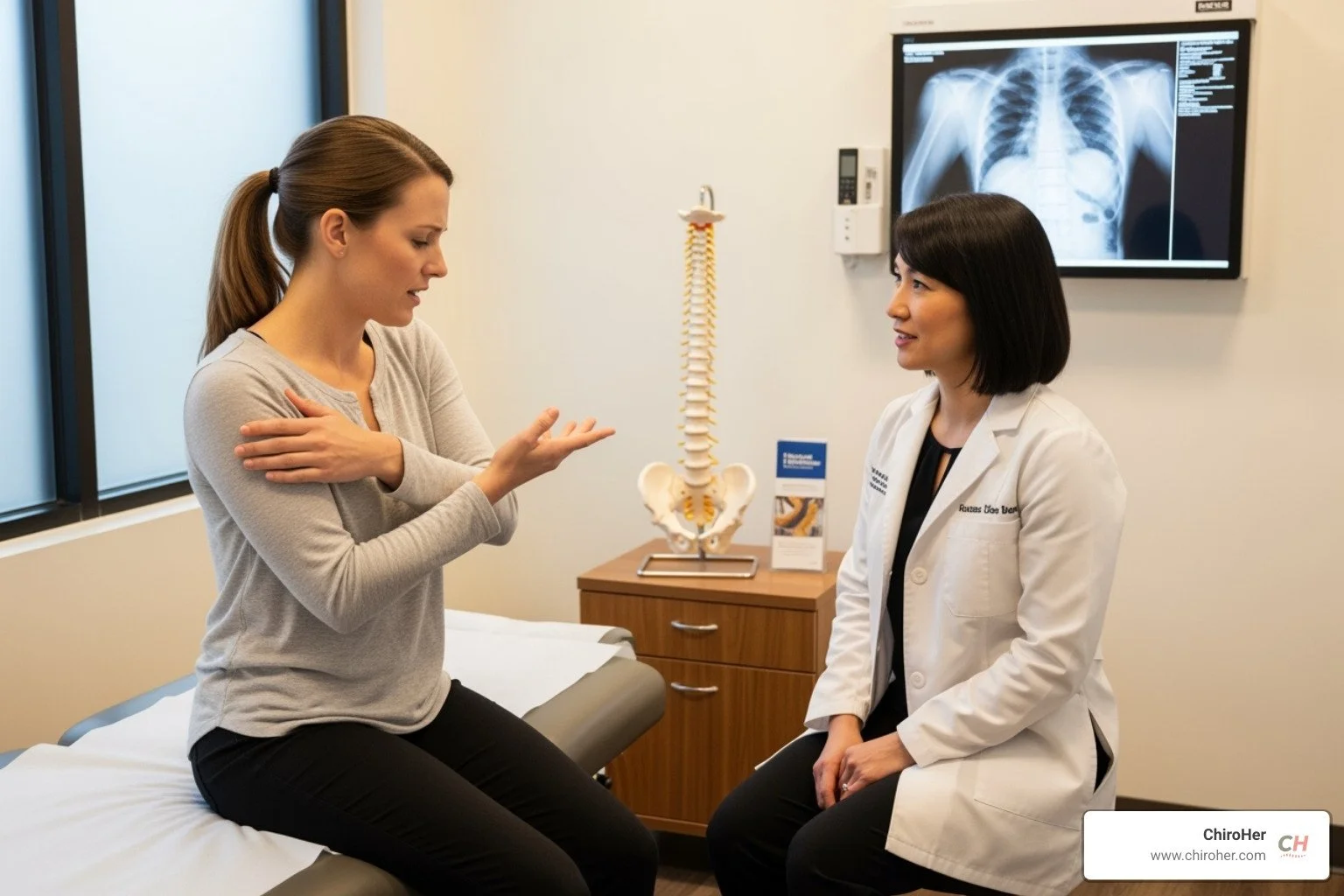Say Goodbye to Neck & Shoulder Pain: Simple Fixes for Fast Relief
Why Understanding How to Relieve Neck Pain and Shoulder Pain Matters for Your Daily Life
Learning how to relieve neck pain and shoulder pain is important, as these interconnected areas affect nearly every movement you make. Nearly one in three people suffer from neck pain, and with our increasingly digital lifestyle, these numbers are rising. Whether you're hunched over a computer, carrying a heavy bag, or sleeping in an awkward position, your neck and shoulders bear the brunt of daily stress.
The connection between neck and shoulder pain is significant. Your cervical spine supports your head, while intricate muscle networks link your neck to your shoulders and upper back. When one area becomes tight or misaligned, it can create a domino effect leading to headaches, reduced mobility, and persistent discomfort.
Hi! I'm Dr. Michelle Andrews, founder of ChiroHer, and I've helped hundreds of patients find effective solutions for persistent neck and shoulder discomfort through personalized chiropractic care. My experience with athletes, expecting mothers, and busy professionals has taught me that true relief requires addressing both immediate symptoms and underlying causes for lasting comfort.
Understanding the Source of Your Neck and Shoulder Pain
Discomfort in your neck and shoulders is your body's signal that something is wrong. The pain often stems from a few key sources we see at ChiroHer, including poor posture, muscle strain, joint issues like arthritis, or nerve compression that can cause sharp, radiating pain.
Common Causes: From Tech Neck to Underlying Conditions
The causes of neck and shoulder pain are diverse, ranging from daily habits to medical conditions. Here are some of the most common:
Soft Tissue Injuries: These include sprains (ligaments) and strains (muscles or tendons) that result from sudden movements or overexertion.
Tech Neck Pain: Spending hours hunched over screens puts immense pressure on the cervical spine, weakening some neck muscles while overworking others. This leads to chronic pain and stiffness. Learn more about this modern issue here: Tech neck pain.
Poor Posture: Incorrect posture while sitting or standing can weaken neck muscles and joints over time, leading to imbalances and chronic pain.
Overuse: Repetitive tasks, especially those involving overhead movements, can lead to conditions like tendinitis or bursitis in the shoulder.
Whiplash: This injury occurs from a sudden back-and-forth head movement, common in car accidents, causing significant neck pain. Learn the distinction from other injuries: Whiplash vs concussion: what's the difference?.
Degenerative Conditions: As we age, spinal discs can stiffen (Degenerative Disc Disease) or cartilage can break down (Cervical Spondylosis), leading to pain. More than 85% of people over 60 are affected by spondylosis. Scientific research on cervical spondylosis.
Disc and Nerve Issues: A herniated disc can press on nerves, causing severe, radiating pain. A pinched nerve (cervical radiculopathy) can also lead to pain, numbness, or weakness down the arm. We explain if chiropractic care can help here: Can chiropractors fix pinched nerves?.
Referred Pain: Sometimes pain is felt in the shoulder but originates in the neck. Rarely, it can be a sign of a serious internal condition, which is why a thorough diagnosis is important.
Recognizing the Symptoms and When to Be Concerned
Knowing the symptoms helps you understand when to seek professional help. While most pain resolves with self-care, certain signs warrant attention.
Common symptoms include stiffness, a dull ache or sharp pain, muscle spasms, and reduced range of motion. You might also experience headaches originating from the neck. Learn more about this connection: Headache and neck stiffness and pain. A “pins and needles” sensation or weakness in the arms or hands often points to nerve involvement.
We strongly advise seeking immediate medical attention if you experience any of the following red flag symptoms:
Pain resulting from a severe blow or injury (e.g., car accident, fall).
Pain that radiates down your arms or legs, especially if accompanied by numbness, tingling, or weakness.
Severe pain that comes on suddenly without obvious cause.
Neck pain accompanied by fever, vomiting, or sensitivity to light (which could indicate meningitis).
Sudden limb weakness or clumsiness.
Chest pain or pressure, especially if it spreads to your arm, jaw, or back (could indicate a heart attack).
Loss of bowel or bladder control.
Abnormal head movement or balance issues.
Swollen glands in the neck or armpit.
How to Relieve Neck and Shoulder Pain with At-Home and Professional Care
Finding relief from neck and shoulder pain can be straightforward. Whether you're dealing with a sudden crick or persistent discomfort, there are proven strategies to help you feel better and prevent future episodes.
Most mild to moderate neck and shoulder pain responds well to self-care measures, especially when caught early.
Immediate Relief: Simple Home Remedies and Self-Care
When neck and shoulder pain strikes, simple home remedies can provide significant relief.
Heat and Cold Therapy: Use a heating pad for chronic stiffness to relax muscles. For acute injuries with swelling, apply an ice pack wrapped in a towel for 15-20 minutes at a time to reduce inflammation.
Gentle Movement: While rest is tempting, prolonged inactivity can worsen stiffness. Once the initial sharp pain subsides, light neck rolls and shoulder movements improve blood flow.
Over-the-Counter Pain Relievers: Medications like ibuprofen or acetaminophen can effectively reduce pain and inflammation in the short term. Always follow dosage instructions.
Sleep Position: Sleeping on your back or side helps keep your spine aligned. A supportive pillow that maintains the natural curve of your neck is also key. If pain disrupts your sleep, it's time to evaluate your habits. Learn more here: Is pain keeping you awake at night?.
Stretches and Exercises for Lasting Neck and Shoulder Pain Relief
Once initial pain subsides, specific stretches and exercises are crucial for long-term relief and flexibility.
Neck Tilts: Gently move your head through its full range of motion: chin to chest, looking up, ear to each shoulder, and turning to look over each shoulder. Hold each position for 5-10 seconds.
Shoulder Rolls: Inhale while lifting your shoulders toward your ears, then exhale as you roll them down and back. This releases tension from hunching.
Chin Tuck: Sit tall and gently tuck your chin in, as if making a double chin, to lengthen the back of your neck. This is excellent for reversing tech neck.
Wall Angels: With your back against a wall, place your arms in a “W” shape with elbows and wrists touching the wall. Slowly slide your arms up and down to improve posture.
Levator Scapulae Stretch: To stretch the side of your neck, place one forearm on a wall, turn your head away from it, and look down. Hold for 10 seconds and switch sides.
Consistency is key. Aim for 10-20 minutes of these exercises daily. For more guided exercises, explore our resources on Correct posture exercises and Therapeutic exercises. Research supports that specific exercise programs significantly reduce neck pain. Scientific research on neck pain exercises.
How to Relieve Neck and Shoulder Pain Through Prevention and Lifestyle Changes
Preventing pain is better than treating it. Small lifestyle changes can make a big difference.
Improve Ergonomics: Adjust your workspace so your computer monitor is at eye level and your chair provides good back support. This keeps your body in a neutral, supported position. More info about workplace ergonomics.
Take Regular Breaks: If you sit for long periods, get up to stretch and move every 30-60 minutes. This prevents muscles from getting stuck in one position.
Manage Stress: Emotional stress leads to tight neck and shoulder muscles. Practices like meditation or deep breathing can help. Learn how chiropractic care can also help: How chiropractic can help alleviate stress.
Stay Hydrated: Your spinal discs need water to maintain their cushioning properties and prevent stiffness. Can dehydration lead to back pain chiroher?.
Lighten Your Load: Avoid carrying heavy bags on one shoulder, which creates uneven strain. Distribute weight evenly or use a wheeled bag.
When to Seek Professional Help for Your Pain
While self-care is effective for many, it's important to know when to see a professional. You should seek professional help for:
Persistent pain that doesn't improve after a few weeks of home care.
Worsening symptoms or pain that interferes with your daily life.
Pain following an injury, like a car accident or fall.
Radiating symptoms like numbness, tingling, or weakness in your arm.
At ChiroHer, we provide personalized care to address both your pain and its underlying causes. Our approach includes chiropractic adjustments to restore spinal alignment and nerve function. Learn more about our methods here: Chiropractic for neck pain. We also use Manual therapy to release muscle tension.
We can help you understand how to relieve neck pain and shoulder pain with a plan that fits your life. Schedule Consultation with our team today to get back to feeling your best.
Building Trust: Authority and Evidence-Based Care
Choosing the right provider for neck and shoulder pain is crucial. At ChiroHer, we provide patient-focused care rooted in scientific evidence and clinical expertise. Our licensed professionals, led by Dr. Michelle Andrews, are committed to delivering award-winning care in a comfortable setting.
We use our expertise in chiropractic, acupuncture, and holistic wellness to offer a comprehensive approach to relieving neck and shoulder pain. Our evidence-based methods are supported by scientific research, ensuring your treatment is both effective and safe. Spinal adjustments, for example, are proven to improve joint mobility and reduce nerve interference.
We also believe in empowering our patients with knowledge. We encourage you to explore reputable sources like the Mayo Clinic to understand your condition better: https://www.mayoclinic.org/diseases-conditions/neck-pain/symptoms-causes/syc-20375581. Combining your understanding with our expert care leads to a more effective recovery.
This article is for informational purposes only and does not constitute medical advice. The information contained herein is not a substitute for, and should not be relied upon for, professional medical advice. Always seek the advice of your physician or other qualified health provider with any questions you may have regarding a medical condition.





